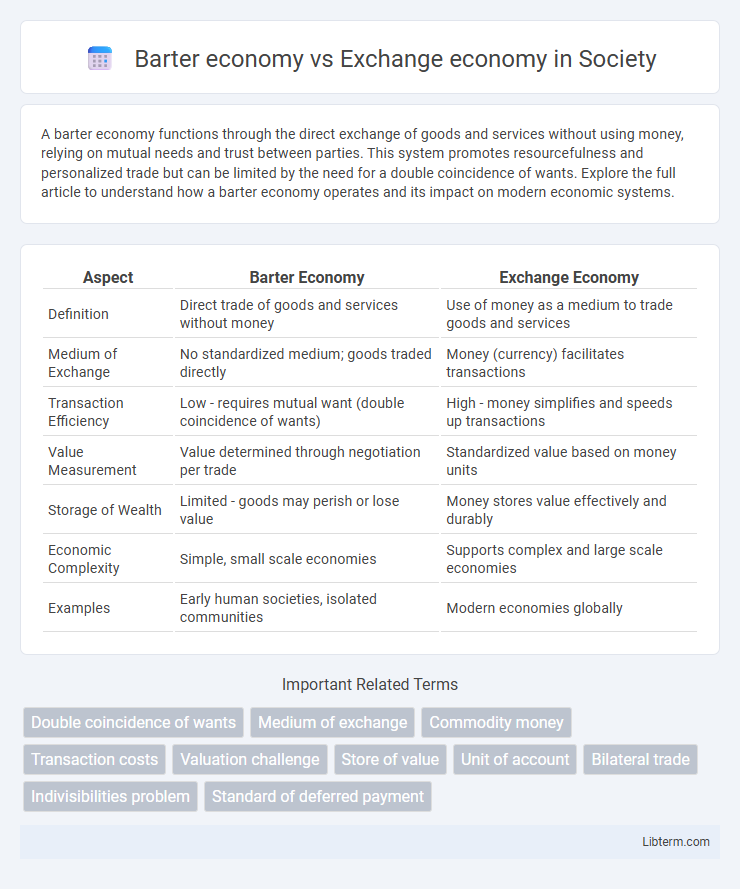A barter economy functions through the direct exchange of goods and services without using money, relying on mutual needs and trust between parties. This system promotes resourcefulness and personalized trade but can be limited by the need for a double coincidence of wants. Explore the full article to understand how a barter economy operates and its impact on modern economic systems.
Table of Comparison
| Aspect | Barter Economy | Exchange Economy |
|---|---|---|
| Definition | Direct trade of goods and services without money | Use of money as a medium to trade goods and services |
| Medium of Exchange | No standardized medium; goods traded directly | Money (currency) facilitates transactions |
| Transaction Efficiency | Low - requires mutual want (double coincidence of wants) | High - money simplifies and speeds up transactions |
| Value Measurement | Value determined through negotiation per trade | Standardized value based on money units |
| Storage of Wealth | Limited - goods may perish or lose value | Money stores value effectively and durably |
| Economic Complexity | Simple, small scale economies | Supports complex and large scale economies |
| Examples | Early human societies, isolated communities | Modern economies globally |
Introduction to Barter and Exchange Economies
Barter economy involves direct trade of goods and services without using money, relying on the double coincidence of wants, which limits transaction efficiency and market expansion. Exchange economy introduces a medium of exchange, such as currency, enabling easier valuation and trade of diverse products, promoting specialization and economic growth. Understanding these fundamental differences is essential in analyzing the evolution of economic systems and market dynamics.
Defining Barter Economy: Key Characteristics
A barter economy operates without a standardized currency, relying on the direct trade of goods and services between participants. Key characteristics include the absence of a common medium of exchange, the need for a double coincidence of wants, and a reliance on mutual negotiation to determine trade terms. This system often results in inefficiencies and limitations in scaling commerce compared to an exchange economy that uses money as a universal medium.
Understanding Exchange Economy: Core Features
An exchange economy operates through the systematic trading of goods and services using a commonly accepted medium, such as money, which facilitates efficient transactions and overcomes the limitations of barter systems. Core features include the presence of a centralized market, standardized pricing mechanisms, and the ability to accumulate wealth or capital, enabling specialization and economic growth. Unlike barter economies, exchange economies reduce transaction costs and improve resource allocation by allowing indirect exchanges and credit systems.
Historical Evolution of Economic Systems
The barter economy, characterized by direct goods-for-goods trade, dominated early human societies before the advent of money, making transactions limited by the double coincidence of wants. The exchange economy emerged with the introduction of standardized currency, enabling more efficient trade, division of labor, and complex market structures. This historical evolution from barter to exchange systems marked a fundamental shift in economic organization, allowing for increased specialization, long-distance trade, and the development of modern financial institutions.
Advantages of the Barter Economy
Barter economy enables direct trade of goods and services without the need for a common currency, reducing reliance on monetary systems. It fosters localized economic interaction and can support communities with limited access to banking infrastructure. This system also allows for flexible negotiation and mutual satisfaction of needs through personalized agreements.
Limitations of Barter Compared to Exchange
Barter economies face significant limitations such as the double coincidence of wants, making transactions inefficient and time-consuming, while exchange economies utilize currency to facilitate smoother and faster trade. Barter lacks a standardized medium of exchange, leading to difficulties in measuring value and storing wealth compared to exchange economies that rely on money as a unit of account and store of value. These constraints hinder economic growth and complexity, which exchange-based systems effectively overcome by providing liquidity and enabling more diverse economic activities.
Benefits of an Exchange Economy
An exchange economy enhances market efficiency by facilitating the smooth transfer of goods and services through standardized currency, which overcomes the limitations of double coincidence of wants inherent in barter systems. It enables price discovery, allowing participants to assess value and make informed economic decisions, thereby promoting specialization and increased productivity. The use of money as a medium of exchange also supports economic growth by expanding trade opportunities and reducing transaction costs.
Challenges Faced by Exchange Economies
Exchange economies face challenges such as price volatility caused by fluctuating supply and demand dynamics, which can disrupt market stability. Transaction costs and the need for a medium of exchange create inefficiencies compared to barter systems, especially in underdeveloped economies without established currency systems. Moreover, information asymmetry and market monopolies can lead to unfair trading practices and economic inequality.
Barter Economy vs Exchange Economy: Key Differences
Barter economy involves direct trade of goods and services without using money, making transactions dependent on a double coincidence of wants. Exchange economy utilizes a monetary system, facilitating easier and more flexible transactions through standardized currency. Barter systems face limitations in scalability and efficiency, while exchange economies enable complex market operations and economic growth.
Future Trends and the Relevance of Both Systems
Barter economy systems are gaining renewed interest through digital platforms and blockchain technology, enabling direct peer-to-peer exchanges without intermediaries, which could revolutionize localized trade and resource allocation. Exchange economies continue to dominate global markets by leveraging monetary systems that facilitate complex and large-scale transactions, supporting economic growth and financial innovation such as digital currencies. Future trends suggest a hybrid model integrating both approaches may emerge, combining the trustless efficiency of electronic barter with the scalability and liquidity of modern monetary exchange systems.
Barter economy Infographic

 libterm.com
libterm.com